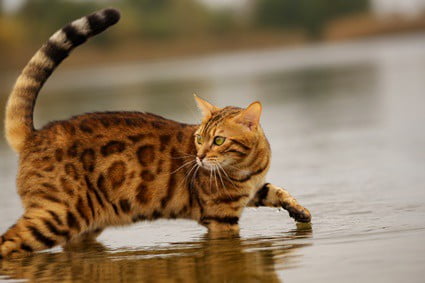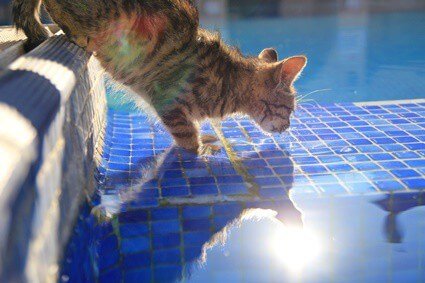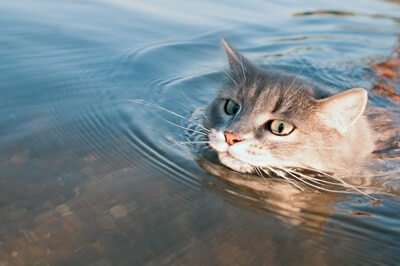It’s believed that cats loathe water, with speculation that it’s because they’re unable to swim. As a natural instinct, they will avoid water to keep themselves from accidentally drowning, or so it’s said. However, many owners have cats that love playing in bathtubs and pools. Like jaguars and tigers, large cat breeds, are often witnessed swimming well and at high speeds. That can leave you puzzled if your domestic cat will be able to paddle to safety if it falls into a pool.
Cats can swim in the water. This is a natural instinct that all felines possess, and most will automatically start paddling when they’re submerged. Young kittens may be less dexterous than adult cats and struggle to swim well. However, they still have the instinct and will become more adept at swimming as they age. With that said, many domestic cats will avoid water because it weighs down their fur and creates an uncomfortable feeling.
Some domestic cat breeds don’t mind this and are prolific swimmers. That includes the Maine coon, Bengal, Turkish van, Savannah, Manx, Norwegian forest cat, Abyssinian, and Japanese bobtail. This may differ depending on individual cats and traumatic experiences with water in their pasts. Despite this, it is possible to teach your cat to swim.
Do Cats Instinctively Know How to Swim?
Cats have an innate knowledge of how to swim. Much like dogs, horses, and other mammals, their survival instinct tells them to begin paddling once they’re submerged. Depending on the cat’s age and experience, the swimming technique may not be graceful or very efficient. However, almost all cats will know to begin swimming if they need to.
With that said, many cats simply prefer not to. Some felines even have physical disabilities that limit how well they can kick their legs or lift their head about the surface.
Very young kittens are the least likely to swim if they need to. As they are still learning how to walk properly, swimming will require too much dexterity and energy, so they are at risk of drowning. Likewise, older cats may have a more refined instinct for swimming but struggle to keep up the strength necessary to swim properly.
Many wild cats swim as a means to ford rivers or streams, to chase prey, or even to stalk prey if necessary. In domestic cats, swimming is more of a survival instinct than a recreational activity. They will avoid water but will start paddling rather than just drown.
Can a Cat Drown?
Despite cats being skilled swimmers, a cat can still drown. Drowning in cats occurs when any liquid enters their airways and obstructs breathing. As such, cats do not always have to be found inside a body of water to drown. If enough liquid has invaded their airways, they can die from drowning on land.
This happens if the cat does not receive any help or medical aid. It is a slow and painful way to go, so if you have any large pools, lakes, or rivers around the vicinity, be careful. You should always supervise your cat around them. Most cats can swim well enough to avoid drowning, but it does happen.
As mentioned, a kitten or senior cat may lack the mobility they need to stay afloat and avoid inhaling water. Even a capable adult cat may get stuck in rough waters or run out of energy before it can pull itself onto land. If you haven’t witnessed your cat expertly swimming in the past, it’s better to be safe than sorry.
The following is a shortlist of clinical symptoms in cats that have water-obstructed airways. If your cat is exhibiting any of these signs, get it to a veterinarian:
- Oversaturated fur
- Extremely rapid or severely slow breathing and/or heart rate
- Increased abdominal effort to breathe
- Pale or blue gums
- Coughing
- Collapse or unconsciousness
How Do Cats Swim?
Cats swim by paddling their legs while keeping their head above water. Although swimming may seem easy, do not expect your feline to be able to swim underwater! It will not know-how and instead risks intense stress and drowning if forced below the water’s surface.
According to Brain Research, cats have very similar locomotory patterns when swimming as they do when walking. There were 2 common movements that felines exercise in both cases:
- The left forelimb moves forward, followed by the right hindlimb
- The left hindlimb moves forward, followed by the right forelimb
These two patterns occur symmetrically on either side, meaning that each movement pattern will occur similarly across the left and right limbs. However, the movement patterns are coupled asymmetrically, across the right and left sides of the cat.
For instance, when the left front leg moves forward, so does the right back leg. When the right front leg moves forward, so does the left back leg. However, forelimbs and hindlimbs on the same side do not move forward at the same time. Both swimming and walking will cycle between these patterns to move forward.
This allows cats to exert the least amount of energy while still propelling themselves at the fastest possible rate. In water, this becomes even more helpful. The diagonal pattern lets them keep their balance and drag more water with each movement. If you are having a hard time visualizing this, carefully observe the way your cat walks. You will note these common movement patterns.
How Far Can Cats Swim?
Large, non-domesticated cat species (such as the tiger, jaguar, and lion) can swim for up to 9 miles. This is because they rely on water to help them thermoregulate, which is how they maintain a healthy body temperature. These predators are also known for scouring for prey along the edges of water in their natural habitat. However, this may not apply to domestic species. That’s because:
- House cats are much smaller than their wild ancestors, so they don’t have the strength and energy to go that far.
- Domestication over the years has possibly changed your cat’s ability to swim for longer distances.
In particular, the domestication process has eliminated the need for house cats to swim at all. This can affect how much dedication your cat puts into swimming and how long it can go before giving up and heading to shore. That makes it difficult to tell its maximum range since it won’t be trying to reach that point. Therefore, how far your cat can swim may vary widely. It depends on:
- Whether it likes water in the first place
- Its size
- Its breed

How Fast Can Cats Swim?
The speed at which cats can swim has not been extensively studied. However, their swimming speed is mostly relative to their body size. Much like their wild ancestors, swimming is always much slower than a cat’s running speed on land.
On average, cats run at maximum speeds of 30 miles per hour. Therefore, you can expect cats to swim at half this speed, at 15 miles per hour, but it will vary based on their overall health and size.
It’s worth noting that cats also rely on their balance to reach higher speeds. In a study by Behavioural Brain Research, 3 cats underwent bilabyrinthectomy, where their inner ears were impaired. They were able to compensate for a partial loss of balance using their sight, but they still struggled to walk in a straight line.
In water, cats do not need to struggle with maintaining perfect balance. As such, older cats may reach higher swimming speeds even if they struggle to pick up the pace on land.
Do Cats Like Swimming?
The answer is mostly yes, and partly no. Most domesticated cats do not like water, much less swimming, and even fear it. However, a handful of cat species do not mind water and even happily swim if given the chance.
Why Do Cats Hate Water?
Cats do not hate the water itself, but rather, they hate what water does to their fur. In particular:
- Saturated fur feels heavy
- Wet fur takes too long to dry
- Water-drenched fur limits how well a cat can hunt or maneuver properly
Cat fur has an expansion rate when drenched in water. Healthy cat fur can absorb more than 30% of its weight in water. This percentage can increase dramatically in damaged fur.
Additionally, fur length can grow by 2%, and the diameter of the hair can grow up to 15-20% longer than when dry. However, this depends heavily on both the health of the fur and the hair follicles. As such, it is no surprise that wet fur can be quite bothersome to deal with.
Retaining a proper body temperature (ideally 100 degrees Fahrenheit) is important to cats. Wet fur can offset this optimal temperature, leaving them extremely cold. This can pave the way for severe illnesses, such as hyperthermia, if your cat cannot dry off promptly.
Why Are Domesticated Cats Afraid of Water?
Domesticated cats are afraid of water mainly due to the above reasons. This can be thought of as fear, as cats do show revulsion to water and try to avoid it. Since fear is often a survival technique to avoid dangerous situations, according to Summa, Animali da Compagnia, some cats do show a genuine phobia. However, most will just react with distaste for the effect water has on their fur.
Some studies have hypothesized that their fear of water may be attributed to evolution. The ancestors of the domestic cats that we know and love today were desert cat species. Being in the desert, they would not be around many bodies of water. Therefore, their descendants evolved to be afraid of water because it was something unfamiliar to them.
With that said, an intense fear of water can arise from past experiences or due to the type of breed that they are. For example, if a cat has a poor or traumatic experience with water in the past, it’s very likely to grow up being afraid of water. Negative associations with water can be anything, ranging from small inconveniences to major trauma, such as:
- Being splashed with water accidentally
- Being left in the rain, without the chance to dry off, and getting sick
Aversion to water is not so easy to overcome in these cats, so do not try to force it unless you have a logical reason to. You may also want to employ the help of animal behaviorists if you are serious about helping your cat get over its fear of water.
Cat Breeds That Like to Swim:
Certain cat breeds are more tolerant of water than others. However, this is a generalization based on certain physical characteristics that they have. You should not assume that this will apply to all individuals within this species because each cat is different.
Additionally, poor experiences will override the fact that many of these cats like water. Here is a list of cat breeds that are more likely to enjoy swimming:
- Maine coon
- Bengal
- Turkish van
- Turkish angora
- Savannah
- Manx
- Norwegian forest cat
- Abyssinian
- American bobtail
- Japanese bobtail
Why Do Some Cats Like Swimming?
The breeds of cats that enjoy swimming also have distinct fur qualities. For instance, the Turkish van is known for its cashmere-like, almost water-repellent long fur. It’s an excellent swimmer with strong back legs and large paws that help it move quite easily in the water.
Other cat breeds, such as the Turkish Angora, Maine coon, and Norwegian forest cat, have water-repellent fur qualities. This allows them to enjoy swimming much more.
Of course, that can be paired with the experiences of their ancestors. For example, the Manx is a breed derived from a cat found on the Isle of Man, an isolated island. Because of its ancestors’ lives on an island surrounded by water, it may be that the Manx does not have a fear of water because of this.
Domestic Bengals are an interesting case because they are commonly only 4 generations removed from their ancestor, the leopard cat. This may be why they do not have a water aversion, in contrast to other cats. They are more recently removed from their leopard ancestor, which does not mind the water so much. In fact, leopards are frequent swimmers and even hunt in the water from time to time for fish and crabs to eat.
How to Teach Cats to Swim
If you are interested in teaching your cats to swim, you are in luck. It is indeed possible! However, there are several things that you need to understand about teaching cats to swim:
- Exposing them as older kittens increases the likelihood of success
- Teaching cats to swim requires a lot of patience and time
- Cats will likely complain by squirming, biting, and scratching. Do not take it personally, but do listen to their body language.
Kittens are much more “moldable” in terms of teaching them behaviors and tricks. However, this is not to say that you cannot teach older cats to swim.
Regardless of what age you begin teaching a cat, training requires an extensive amount of patience and time. Remember, these animals are typically not adjusted to like water! You are dually teaching them to overcome their fears and swim willingly, which is not an easy feat to accomplish in a short amount of time.

Introduce The Cat To Water
You should begin by making the feline comfortable with approaching water. If you have a pool, either a normal-sized one or even a kiddie one, start here. Try to see if you can get the cat to come near you while you’re in the water.
If the cat doesn’t appear receptive, you can use your bathtub and leave the doors to the bathroom open. This will let the cat investigate it. Having treats on hand will be useful. Do not touch the cat with wet hands or splash it with water.
Let It Take A Dip
Once the feline is comfortable approaching you and your pool or bathtub, you want to carry it inside. Slowly dip small portions of the cat’s body in.
If you are introducing it into a pool, ensure that the chlorine levels are below 4mg per liter for extra safety. This also lowers the chances of deterring your cat with the smell.
Begin by dipping the tips of the cat’s feet, tail, or the bottom of its belly. Make sure you keep a comfortable and firm hold on the cat. Monitor its behavior and be sure to soothe it because it will complain. If it seems comfortable, sit in the water while still holding it, making sure its head is still above the water level.
Let The Cat Swim
After some time, loosen your hold on the cat, but do not let go quite yet. Instead, gradually ease your hold and let it adjust to being away from you and in the water alone.
The cat will get the hang of swimming rather quickly. If at any time your cat panics, you want to remove it from the water and dry it off immediately. Do not be discouraged, be patient, and always keep a towel at the ready.
Many domestic cats do have the innate knowledge to swim and can swim quite well. However, this is mainly a survival instinct. Regardless of that, under no circumstances should you expect that your cat knows how to swim without any supervision. Cats can still drown. If you have a backyard pool, make sure to keep it covered or prevent your cat from going outside when you cannot watch it.

